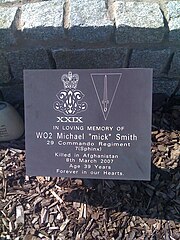29 Commando Regiment is the Commando-trained unit of the British Army's Royal Artillery. The regiment is under the operational control of 3 Commando Brigade providing artillery support and gunnery observation.
History[]
29 Field Regiment Royal Artillery became 29 Commando Light Regiment Royal Artillery in 1962. This consisted of three gun batteries numbered 8 (Alma), 79 (Kirkee), and 145 (Maiwand). At that time, each battery consisted of 4 x 105mm pack howitzers (Italian Mountain Gun) and manned with approximately 65 men.
The early commando training was initiated in the Royal Citadel at Plymouth with a four-week 'beat up' to select those who would go on to CTCRM Lympstone and complete the five week Commando course (X Troop) with the Royal Marine trainees where all qualified for the Green Beret.
In 1965, 95 Commando Light Regiment Royal Artillery formed with 8 (Alma) moving from 29 and 7 (Sphinx) came out of mothballs. From 1965 until 1970 the two regiments were based alternately in Singapore or The Royal Citadel in Plymouth.
The Naval gunfire support batteries were 20 Battery with 29 Regiment and 148 (Meiktila) Battery with 95 Regiment.
During this period the regiments saw action in Aden and Borneo as well as spending time on HMS Albion, HMS Bulwark, HMS Intrepid, and HMS Fearless travelling to trouble spots worldwide.
In 1971 the two regiments joined together and formed 29 Commando Regiment Royal Artillery with four gun batteries. The Naval Gunfire Support batteries became 95 Commando Forward Observation Unit.
The Gun Batteries were then attached to a Royal Marine Commando as part of a Commando Group. For example 45 Commando Group consisted of 45 Commando Royal Marines, 7 (Sphinx) Commando Battery Royal Artillery, 45 Commando Air Squadron, Condor Troop Royal Engineers and an Ordnance section. The regiment was stationed in Northern Ireland in the early 1970s.[1]
During the 1982 Falklands War, 29 Commando Regiment accompanied the Royal Marines, providing much needed support with their L118 Light Guns.[2]
In 1996, during the celebrations of the regiment's centenary in the Citadel in Plymouth, the honorary Freedom of the City of Plymouth was conferred on the regiment (with the unanimous support of Plymouth City Council).[3]
They were also sent to Afghanistan to help with the operations against Al Qaeda and Taliban militants.[4]
Composition[]

Practice firings by 7 (Sphinx) Commando Battery on exercise near Cape Wrath in Scotland.
After the Army 2020 refines the regiment now controls:
- Regimental Headquarters at Plymouth
- 7 (Sphinx) Commando Battery - Tactical Control Group Battery
- 23 (Gibraltar 1779-83) Battery - Headquarters Battery
- 79 (Kirkee) Commando Battery - Light Gun Battery
- 148 (Meiktila) Commando Forward Observation Battery - Naval Gunfire Support
- Reserve Artillery Troop at Plymouth - Reserve Artillery Support
- Corps of Royal Electrical and Mechanical Engineers Light Aid Detachment
Selection and training[]
Soldiers volunteer for 29 Commando Regiment from the regular units of the Royal Artillery, Royal Electrical and Mechanical Engineers, and other attached arms and services (e.g. chefs, clerks etc.) and are required to undergo Commando training following entry to the regiment.
Personnel are inducted into 'PC Troop' (Potential Commando Troop) and taken through a six-week foundation course at Okehampton, covering the basics of field craft, navigation, physical training, skill at arms and commando history. The course teaches anything that may have been missed in Phase One and Phase Two training as well as new commando skills.
After completing foundation, candidates start the four week Commando Conditioning Course (CCC) or otherwise known as 'beat-up'. This is a rigorous phase where personnel are required to pass multiple criteria tests in all aspects of commando training in order to qualify for the All Arms Commando Course (AACC).
The AACC is an arduous nine-week course conducted at the Commando Training Centre Royal Marines at Lympstone, Devon culminating in the Commando tests and leading to the award of the Green beret.
Gunners then go on to complete further specialist training as required.

Memorial to member of the Regiment killed in Afghanistan
See also[]
References[]
- ↑ "3 April 1973 → Written Answers (Commons) → DEFENCE". Hansard, UK Parliament. 3 April 1973. http://hansard.millbanksystems.com/written_answers/1973/apr/03/northern-ireland. Retrieved 2009-08-12.
- ↑ Fairhall, David (21 May 1982). "Why British invasion will be risky affair". The Sydney Morning Herald. http://news.google.com/newspapers?id=bjsRAAAAIBAJ&sjid=BOcDAAAAIBAJ&pg=6035,7323212&dq=29th-commando-regiment+royal-artillery. Retrieved 2009-08-12.[dead link]
- ↑ "House of Commons Hansard Debates for 1 Feb 1996 (pt 18)". Hansard, UK Parliament. 1 Feb 1996. http://www.publications.parliament.uk/pa/cm199596/cmhansrd/vo960201/debtext/60201-18.htm. Retrieved 2009-08-12.
- ↑ Gall, Carlotta (6 May 2002). "From Hilltop Perch, British Troops Watch for Holdouts". The New York Times. http://www.nytimes.com/2002/05/06/world/from-hilltop-perch-british-troops-watch-for-holdouts.html. Retrieved 2009-08-12.
External links[]
| Wikimedia Commons has media related to 29th Commando Regiment, Royal Artillery. |
| |||||||||||
| |||||||||||||||||||||||||||||||||||
The original article can be found at 29th Commando Regiment Royal Artillery and the edit history here.